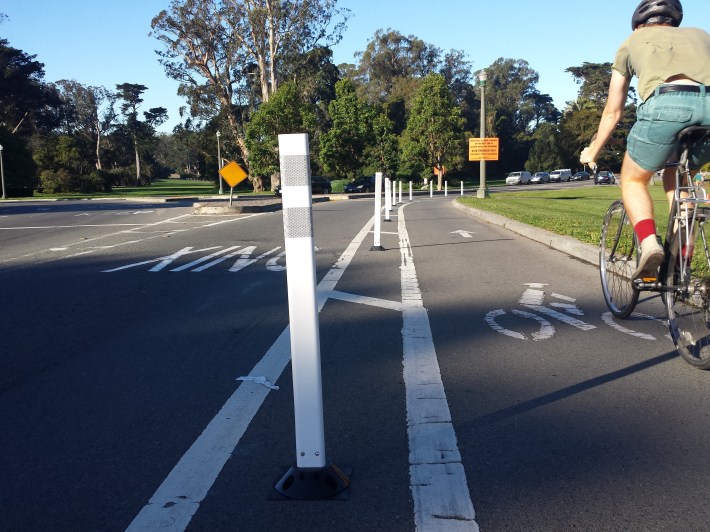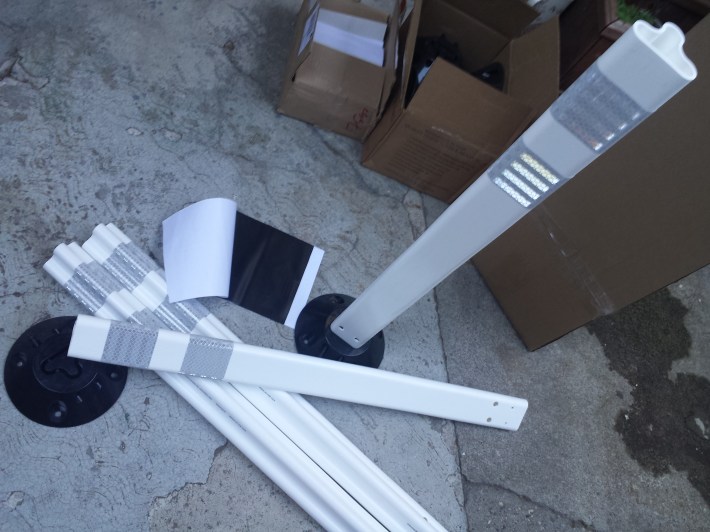
San Francisco cyclists may have noticed a safety improvement at JFK and Kezar, where Golden Gate Park meets the Panhandle. That notorious intersection now has more than paint to segregate cars, pedestrians, and cyclists: plastic, safe-hit posts popped up late last week. And they seem to be working, effectively keeping motorists out of the bike lane.
But don't thank the San Francisco Rec and Parks Department for installing them. SFMTA? Nope. Is it because of Mayor Edwin Lee's "Executive Directive" on safety. Guess again.
The posts were glued down by fed-up citizen volunteers. That's right: it's an illegal installation.
"We've all done our civic duty and due diligence to make things better within the system. All we got was frustrated," said a member of the San Francisco Metropolitan Transformation Authority, also known as the SFMTrA.
From the SFMTrA website:
The San Francisco Metropolitan Transformation Authority is a collective organization of men and women committed to making streets safer for pedestrians and cyclists, and doing it quickly. We were founded in 2016 in direct response to the deaths of two cyclists on the city's streets on the same day.
The two deaths, of course, were Heather Miller and Kate Slattery--two women killed in different parts of San Francisco, on June 22. That horrific night was a clarion call that our city agencies are undeniably not working fast enough to make our streets safe, something that's been echoed by Members of the Board of Supervisors and, at long last, the Mayor himself.
Obviously, Streetsblog has to withhold the identities of the guerrilla advocates. But here's what else they had to say: "We weren't seeing quick fixes, we weren't seeing a high degree of care and concern...what else do you do if you've gone through all the appropriate protocols? The next thing to do is take direct action."
This is not the first direct action by the group, which has affiliates throughout the country. But previous "installations" consisted of some paint and dropping down some safety cones, without attaching them to the pavement. The safe-hit posts, on the other hand, aren't going anywhere for a while, unless effort is made to remove them.

"They're attached using butyl pads, a pressure adhesive--the sticky pad goes on the street and you roll over it with a car tire, which firmly glues it in place," said the unofficial spokesperson for the SFMTrA. "It's not technically considered permanent, but it's much more than cones."
This particular installation was about a mile from where Miller was killed, on a notoriously dangerous spot that cyclists had posted about frequently on the group's web page. They also have instructions about where to buy the posts and do your own installations. According to the spokesperson, the installation only took a couple of hours and required no more than two people--although more were present. The posts cost about $30 each.
So what does the SFMTA think about this? Here's a statement from spokesman Paul Rose:
We certainly understand that people are passionate about safety. We are too. In 2010, we had zero miles of protected bike lanes and zero miles of buffered bike lanes in San Francisco. Since then, we’ve installed 27 miles of bike lanes that are either protected from traffic by things like parked cars or curbs, or have a space buffer between them and vehicles so people on bikes are safer.
We have no other choice but to remove the cones placed on the road by SFMTrA, because it is a code violation to place objects in the roadway and they could create conflicts for transit in the areas where they have been placed.
This is pretty much what one would expect from a city agency; obviously, an SFMTA's spokesman is not going to encourage law breaking. But Streetsblog has to wonder, as long as the posts are inside a buffer zone where transit and other vehicles are not supposed to be anyway, how can the posts create conflicts? Only an inattentive motorist or bus driver can do that. And isn't that the whole point of a safe-hit post: to intentionally create a potential conflict between a plastic post and a deadly vehicle, to avoid a crash between a cyclist and a deadly vehicle?
So until the City of San Francisco starts dropping planters, safe-hit posts, Jersey barriers, old railway ties, or whatever else it takes to keep cyclists from getting sent to the hospital and the morgue, how can anyone tell SFMTrA that they're wrong?
Streetsblog knows there are plenty of people at SFMTA, the parks department, and the SFPD who are sympathetic with these guerrillas. We can only urge that, unless you really think SFMTrA has made an intersection or street tangibly more dangerous--which seems pretty unlikely--do your best to look the other way. SFMTrA reported that the police saw them working on the safe-hit posts, but opted to do just that.
Maybe the answer for the city is to figure out how to make these projects retroactively official. Or the city has to develop ninja safety installation teams of its own that can run out and put down safe-hit posts, planters, or whatever it takes, in hours rather than months and years.
"Our response would just be that we hope they will not remove our installations, which are increasing safety in the short term, unless they immediately install infrastructure of equal or greater quality," said the SFMTrA spokesperson.
Meanwhile, here's a look at the plastic bollards in action, courtesy of "Asumu Takikawa" via the SFMTrA Twitter feed, with the comment "Cars seem to be going slower and def. no encroachment. Thanks so much! #postsonJFK"
. @SFMTrA a bit late to this but here's one from today. Cars seem to be going slower and def. no encroachment. Thanks so much! #postsonJFK pic.twitter.com/hO2FxV9qw2
— Asumu Takikawa (@asumu) October 5, 2016





